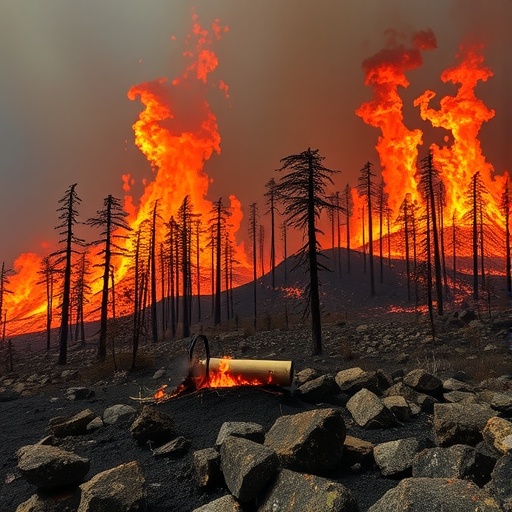In a groundbreaking study, researchers have delved into the intricate relationship between ancient agro-pastoralist societies in the South Central Andes and their environmental practices, particularly through the lens of wood burning. This investigation, conducted by Rodriguez and Babot, highlights the transition from the lush Yungas subtropical mountain forest to the arid Puna high desert, focusing on how these communities utilized allochthonous woods, which originate from outside their immediate ecological surroundings. The findings provide a nuanced understanding of the socio-environmental dynamics prevalent between 1584 and 830 BP, drawing insights into both ecological adaptations and cultural practices.
The research underscores that the burning of allochthonous woods was not merely an environmental necessity but an integral aspect of the socio-cultural fabric of these indigenous communities. This practice was significant for various reasons, including the cultivation of agricultural lands, the management of fire regimes, and the establishment of communal rituals. It also demonstrates a sophisticated understanding of their environment, as the communities adeptly managed and manipulated their surroundings to align with their subsistence needs.
By examining archaeological remnants and employing advanced analytical techniques, the study reveals how agro-pastoralists adapted their resource use in relation to climatic and ecological shifts in the landscape. The transition from forest to desert poses considerable challenges to traditional lifestyles, yet this research indicates a remarkable resilience and adaptability among the communities. Understanding these ancient coping strategies sheds light on contemporary issues of climate change and environmental degradation faced by modern societies.
Moreover, the authors meticulously analyze charcoal samples found at archaeological sites, which provide crucial data on the timing and extent of wood burning practices. These analyses point to variations in species selection and burning techniques over time, suggesting a highly developed knowledge system regarding fire management. Such insights not only inform us about ancient environmental practices but also contribute significantly to our understanding of biodiversity conservation and sustainable resource management today.
In their exploration of the Yungas and Puna regions, the researchers highlight the importance of geographical context in shaping cultural practices. The transition from a biodiverse forest to a high-altitude desert inevitably influenced the materials available for construction, fuel, and craftsmanship. The reliance on allochthonous woods indicates a flexible approach to resource use, showcasing the community’s innovative spirit and their ability to maintain sustainable practices despite ecological constraints.
Additionally, this study emphasizes the role of fire as a tool for landscape management. Fire regimes employed by these societies were not only about clearing land but were also integral to promoting the growth of desired plant species, enhancing soil fertility, and preventing invasive species from taking hold. This integrated approach to land management serves as an important lesson for modern ecological practices, especially in an age where land degradation is rampant.
As societies across the globe grapple with the effects of climate change, the study’s findings can inspire contemporary conversations about sustainable agricultural practices. The research highlights how ancient societies effectively navigated environmental challenges, employing wisdom that can be translated into modern-day resilience strategies. By learning from the agro-pastoralist practices of the South Central Andes, current agricultural stakeholders can rethink their approaches to cultivate lands in harmony with ecological systems.
Another noteworthy aspect includes the cultural dimensions associated with wood burning. The ritualistic aspects tied to fire management reflect deeper social values and community cohesion. Such practices often included ceremonies and traditions that reinforced group identity and social bonds among community members. The blending of ecological and cultural narratives provides a holistic view of how indigenous practices can contribute to maintaining biodiversity while also fostering social unity.
In conclusion, the work by Rodriguez and Babot is not merely an academic endeavor; it is a vital exploration that bridges the past with the present. By examining how agro-pastoralist societies adapted to their changing environments over a millennium ago, the study is a clarion call to recognize the significance of traditional ecological knowledge. It encourages modern scientists and policymakers to engage with indigenous practices and wisdom, which may hold a key to building sustainable futures amid ongoing environmental crises.
As we advance toward an uncertain future marked by global climate shifts, the insights derived from ancient practices in the South Central Andes could be pivotal. They serve as reminders of human resilience and adaptability, as well as the intricate bonds we share with our environment. This revolutionary research spells optimism for future generations, emphasizing the need for interdisciplinary collaboration that honors both the lessons of history and the exigencies of contemporary ecological challenges.
In reading this research, we glean that the temperature of historical relevance is not merely of the past; it propels us into an urgent dialogue about how we may engage responsibly and sustainably with our environment moving forward. The wisdom of these ancient agro-pastoralists provides a guiding light for all of humanity, inviting us to cultivate a relationship with the earth that is both respectful and sustainable.
Subject of Research: Ancient agro-pastoralist practices and environmental adaptation in the South Central Andes.
Article Title: From the Yungas subtropical mountain forest to the Puna high desert: insights on the burning of allochthonous woods by agro-pastoralist societies of the South Central Andes of Argentina (1584 − 830 BP).
Article References: Rodriguez, M.d., Babot, M.d. From the Yungas subtropical mountain forest to the Puna high desert: insights on the burning of allochthonous woods by agro-pastoralist societies of the South Central Andes of Argentina (1584 − 830 BP). Archaeol Anthropol Sci 17, 205 (2025). https://doi.org/10.1007/s12520-025-02312-5
Image Credits: AI Generated
DOI: https://doi.org/10.1007/s12520-025-02312-5
Keywords: Agro-pastoralism, wood burning, South Central Andes, resilience, ecological adaptation, cultural practices, sustainability, indigenous knowledge.




